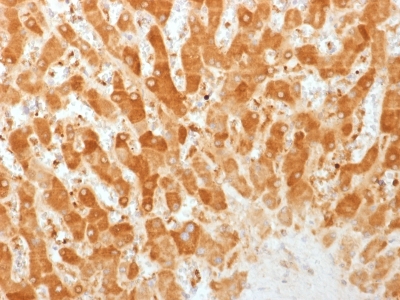Human, Mouse, and Rat Anti-Connexin 32 Antibody Product Attributes
Connexin 32 Previously Observed Antibody Staining Patterns
Observed Antibody Staining Data By Tissue Disease Status:
Tissues from cancer patients, for instance, have their own distinct pattern of Connexin 32 expression as measured by anti-Connexin 32 antibody immunohistochemical staining. The average level of expression by tumor is summarized in the table below. The variability row represents patient to patient variability in IHC staining.
| Sample Type | breast cancer | carcinoid | cervical cancer | colorectal cancer | endometrial cancer | glioma | head and neck cancer | liver cancer | lung cancer | lymphoma | melanoma | ovarian cancer | pancreatic cancer | prostate cancer | renal cancer | skin cancer | stomach cancer | testicular cancer | thyroid cancer | urothelial cancer |
|---|---|---|---|---|---|---|---|---|---|---|---|---|---|---|---|---|---|---|---|---|
| Signal Intensity | +++ | ++ | ++ | +++ | +++ | + | + | ++ | ++ | + | ++ | +++ | +++ | +++ | + | + | +++ | ++ | + | ++ |
| GJB1 Variability | ++ | ++ | ++ | + | ++ | ++ | ++ | ++ | ++ | ++ | ++ | ++ | ++ | + | ++ | + | ++ | ++ | ++ | ++ |
| Connexin 32 General Information | |
|---|---|
| Alternate Names | |
| Gap junction beta-1 protein, GJB1, connexin 32, Cx32 | |
| Molecular Weight | |
| 27-32kDa | |
| Chromosomal Location | |
| Xq13.1 | |
| Curated Database and Bioinformatic Data | |
| Gene Symbol | GJB1 |
| Entrez Gene ID | 2705 |
| Ensemble Gene ID | ENSG00000169562 |
| RefSeq Protein Accession(s) | NP_000157, XP_011529209, NP_001091111, XP_016884897 |
| RefSeq mRNA Accession(s) | XM_011530907, XM_017029408, NM_001097642 NM_000166 |
| RefSeq Genomic Accession(s) | NC_000023, NG_008357, NC_018934 |
| UniProt ID(s) | P08034 |
| UniGene ID(s) | P08034 |
| HGNC ID(s) | 4283 |
| Cosmic ID(s) | GJB1 |
| KEGG Gene ID(s) | hsa:2705 |
| PharmGKB ID(s) | PA28694 |
| General Description of Connexin 32. | |
| This Ab recognizes a protein of 27-32kDa, identified as Connexin 32. The connexin family of proteins forms hexameric complexes called connexons that facilitate movement of low molecular weight proteins between cells via gap junctions. Connexin proteins share a common topology of four transmembrane ?-helical domains, two extracellular loops, a cytoplasmic loop and cytoplasmic N- and C-termini. Many of the key functional differences arise from specific amino-acid substitutions in the most highly conserved domains, the transmembrane and extracellular regions. Each of the approximately 20-connexin isoforms produces channels with distinct permeability and electrical and chemical sensitivities ;therefore, one connexin usually cannot fully substitute for another. | |




Reviews
There are no reviews yet.